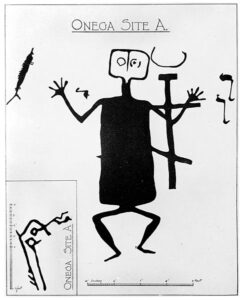Introduction to Lake Onega Petroglyphs
Lake Onega, located in the Karelia region of Russia, is home to one of the world’s most remarkable ancient artistic treasures: petroglyphs dating back to around 4000 BCE. Among the over 1,200 carvings, the most prominent is a 5-meter-tall anthropomorphic figure known as “The Devil” (Russian: Bes). These carvings not only showcase the artistic skill of prehistoric people but also reveal sacred stories and beliefs.
The “Devil” Carving and Its Unique Significance
The Bes carving stands out as the most extraordinary piece at Lake Onega. Measuring 5 meters tall, it is remarkable not only for its size but also for the way the ancient artist cleverly incorporated the natural terrain. A large crevice in the rock bisects the figure, creating a dramatic and enigmatic visual effect.
This deliberate use of the crevice might have symbolic meaning. Some researchers suggest that the division could represent the separation between the human world and the divine realm or symbolize dualities in nature, such as light and darkness or life and death. While its modern name, “The Devil,” was given by locals, it may have originally depicted a deity or guardian spirit.

Other Carvings at Lake Onega
Beyond Bes, the petroglyphs at Lake Onega depict a wide range of themes, including:
- Animals: Carvings of elk, fish, and birds highlight the importance of hunting and fishing in the lives of ancient inhabitants.
- Boats: Images of large boats appear frequently, possibly representing travel, trade, or ritual practices.
- Abstract patterns: Spirals, circles, and repeated geometric motifs might carry symbolic or astronomical significance.
These images provide a fascinating glimpse into the material and spiritual lives of prehistoric communities, showcasing their daily activities as well as their beliefs and ceremonies.
Artistic and Technical Analysis
The petroglyphs were created by directly carving into the hard granite surfaces of the rocks, a process that required advanced techniques and appropriate tools. This demonstrates that the people of the time possessed both artistic creativity and mastery of stone and bone tools.
- Carving techniques: The artists used shallow incisions to create clear lines, ensuring the images would endure for millennia.
- Integration with natural features: Many carvings, like Bes, creatively combine artistic elements with geological features, enhancing their symbolic power.

Cultural and Archaeological Significance
The Lake Onega petroglyphs are a cultural treasure of global importance, valued not only for their aesthetic appeal but also for the stories they convey.
- Reflection of ancient beliefs: These carvings might have been part of religious rituals or served as records of sacred legends.
- Historical documentation: They provide evidence of how prehistoric humans interacted with their environment, utilized resources, and communicated ideas visually.
- Artistic inspiration: The sophistication of these carvings shows that Stone Age humans had a profound understanding of art and aesthetics.

Preservation and Value Enhancement
Today, the Lake Onega petroglyphs face threats from climate change, natural erosion, and human activities. Preserving these treasures is not only Russia’s responsibility but also a global mission. Necessary measures include:
- Conducting further research to uncover their cultural and scientific significance.
- Strengthening legal and international efforts to protect the site.
- Raising public awareness and promoting sustainable tourism.
Conclusion
The petroglyphs at Lake Onega are not only evidence of the artistic capabilities of prehistoric humans but also keys to understanding their worldview and beliefs. The carving of Bes and the other works in this area are invaluable legacies, reminding us of the creativity and deep connection between humans and nature.
